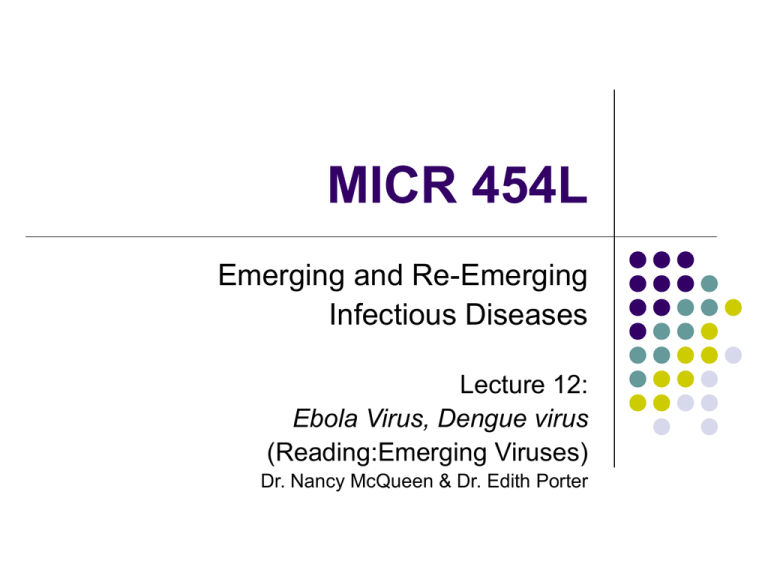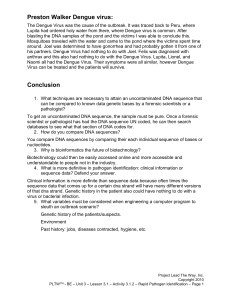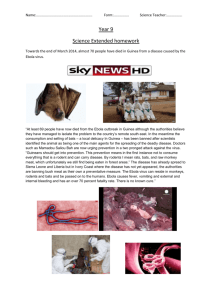
MICR 454L
Emerging and Re-Emerging
Infectious Diseases
Lecture 12:
Ebola Virus, Dengue virus
(Reading:Emerging Viruses)
Dr. Nancy McQueen & Dr. Edith Porter
Overview
Ebola Virus
Dengue Virus
Brief history
Morphology
Genome
Replication cycle
Diseases
Pathogenesis
Diagnosis
Treatment
Prevention
Threats
Ebola Virus
Ebola Virus - Brief History
In 1976 two epidemics of hemorrhagic fever occurred
simultaneously in Zaire and Sudan.
Over 500 cases were reported with a mortality rate of
88% in Zaire and 54% in Sudan
A new virus that was isolated as the causative agent was
named after the Ebola River in Zaire.
Subsequent outbreaks occurred in Sudan in 1977 and
1979.
In 1994 the first Ebola case was reported in West Africa.
In 1989 an outbreak occurred in cynomolgus monkeys
imported from the Philippines to a facility in Reston,
Virginia .
Luckily that species does not appear to be pathogenic to humans
Ebola Virus - Brief History
Sporadic outbreaks, most in equatorial Africa, continue
to occur
Endemic in Sudan, Zaire, and the Ivory Coast.
Very pathogenic for monkeys and apes - argues against
these animals as the natural host.
Recent studies - virus can replicate in fruit and insecteating bats without any ill effects to the bat.
Thus, bats may be the natural reservoir for the virus.
Ebola Virus - Taxonomy
Ebola virus belongs to the family Filoviridae, genus
Ebolavirus
There are four identified subtypes, three of which
infect humans
Filamentous, helical, enveloped virus
Linear SS, - RNA genome
Ebola Virus Replication Cycle
Budding from the
plasma membrane
Penetration
via receptor
mediated
endocytosis
mRNA synthesis and genome
replication in the cytoplasm
Fusion with
endosomal
membrane
(uncoating)
Ebola Virus – Transmission to
Humans
How the virus first appears in a human at the start of an
outbreak has not been determined.
? contact with an infected animal.
After the first case-patient in an outbreak setting is
infected, virus can be transmitted via:
Direct contact with the blood and/or secretions of an infected
person.
Contact with objects, such as needles, that have been
contaminated with infected secretions.
Sexual contact
Aerosol transmission has been documented in non-human
primates, but not in humans
Ebola Virus Diseases/Pathogenesis
Incubation - 2 to 21 days
Symptoms
abrupt - characterized by fever, headache, joint and
muscle aches, sore throat, and weakness
followed by diarrhea, vomiting, and stomach pain
rash, red eyes and hiccups may also occur
dendritic cells and macrophages initially infected followed
by hepatocytes, and, in latter stages, endothelial cells.
virus evades host defenses by producing proteins (vp24,
vp35) that interfere with interferon signaling pathway.
Ebola Virus – Pathophysiology
of the Disease
Clinical infection in human and nonhuman primates is
associated with rapid and extensive viral replication in all
tissues.
A viral glycoprotein, sGP binds to a neutrophil-specific
receptor and inhibits early neutrophil activation.
Viral replication is accompanied by widespread and severe
focal necrosis.
The most severe necrosis occurs in the liver.
sGP also may be responsible for the profound lymphopenia
that characterizes Ebola infection
A second viral glycoprotein binds to endothelial cells but
not to neutrophils, allowing Ebola virus to invade,
replicate in, and destroy endothelial cells.
Ebola Virus - Pathophysiology
of the Diseases
Destruction of endothelial surfaces causes the vessels to
leak and bleed.
Destruction of the endothelial surfaces can lead to
disseminated intravascular coagulation (DIC), and this,
combined with the liver destruction may contribute to the
hemorrhagic manifestations that characterize Ebola
infections.
The two major factors in Ebola virus pathogenesis are
the impairment of the immune response and vascular
dysfunction.
Death results from liver damage and dysfunction, shock,
and the DIC which leads to internal and external
bleeding
mortality rate ranges from 30-90%
Ebola Hemorrhagic Fever
Ebola Virus- Diagnosis
Serology
Molecular tests
ELISA
RT-PCR
Virus isolation - Must use biocontainment
level IV facility!
Ebola Virus - Treatment
There is no standard treatment for Ebola
hemorrhagic fever (HF).
Patients receive supportive therapy balancing the patient’s fluids and electrolytes,
maintaining their oxygen status and blood
pressure, and treating them for any
complicating infections.
Ribavirin treatment has been tried with little
success.
Ebola Virus - Prevention
No vaccine is currently available, but many are in
development
Practical viral hemorrhagic fever isolation
precautions, or barrier nursing techniques must be
used. These techniques include
the wearing of protective clothing, such as masks, gloves,
gowns, and goggles
the use of infection-control measures, including complete
equipment sterilization
the isolation of Ebola HF patients from contact with
unprotected persons.
direct contact with the body of a deceased patient should
be prevented.
Ebola Virus - Threats
Sporadic epidemics continue to occur
challenge of developing additional diagnostic tools to assist
in early diagnosis of Ebola HF
challenge of conducting ecological investigations of Ebola
virus and its possible reservoir (bats).
challenge to determine how the virus is transmitted to
humans must be acquired to prevent future outbreaks
effectively.
Use as bioterrorism weapon
Kills too quickly?
Aerosol spread?
Take Home Message
Ebola virus belongs to the family Filoviridae
Enveloped with linear SS, - RNA genome
Reservoir appears to be bats
Virus targets dendritic cells, macrophages, hepatocytes,
endothelial cells
Virus impairs immune function in several ways
Liver and endothelial cell destruction DIC internal and
external bleeding
High mortality rate
Diagnosis via serology, molecular tests, virus isolation (level
IV biocontainment)
Treatment - supportive care
Vaccines in development
Dengue Virus
Brief History
The first cases of Dengue Fever (DF) were recorded
in 1779 in Batavia, Indonesia, and Cairo
In 1780, there was an epidemic reported in
Philadelphia, PA.
For the past 200 years, pandemics have been
recorded in tropical and subtropical climates at 10 to
30 year intervals.
Although DF is not a new disease, it can be
classified as an emerging disease.
Since 1945, the number of reported cases of DF
surged because of increased urbanization and travel
Dengue Virus- Classification
Is in the family Flaviviridae, genus flavivirus
Belong to Group B arboviruses (arthropod borne
animal viruses)
Transmitted by female Aedes aegypti mosquitoes
Has 4 serotypes (DEN-1, 2, 3, 4)
Enveloped, single-stranded + RNA genome
Dengue Virus
Replication Cycle
Budding from
ER
exocytosis
mRNA synthesis
and genome
replication in the
cytoplasm
Transmission of Dengue Virus
by Aedes aegypti
Mosquito feeds /
acquires virus
Mosquito refeeds /
transmits virus
Intrinsic
incubation
period
Extrinsic
incubation
period
Viremia
Viremia
0
5
Illness
Human #1
8
12
16
DAYS
Human #2
20
24
Illness
28
Replication and Transmission
of Dengue Virus
1
1. Virus transmitted
to human in mosquito
saliva
2
4
2. Virus replicates
in target organs
3. Virus infects white
blood cells and
lymphatic tissues
4. Virus released and
circulates in blood
3
Replication and Transmission
of Dengue Virus
5. Second mosquito
ingests virus with blood
6. Virus replicates
in mosquito midgut
and other organs,
infects salivary
glands
7. Virus replicates
in salivary glands
6
7
5
Diseases
Undifferentiated fever
Classic dengue fever
Dengue hemorrhagic fever
Dengue shock syndrome
Undifferentiated Fever
most common manifestation of dengue
87% of students infected are either
asymptomatic or only mildly symptomatic
Classic Dengue Fever
Fever
Headache
Muscle and joint pain
Nausea/vomiting
Rash (petechiae)
Hemorrhagic manifestations
Encephalitis
Decreased level of consciousness: lethargy, confusion,
coma
Seizures
Nuchal rigidity
Paresis (slight paralysis)
Petechiae
Dengue Hemorrhagic Fever
(DHF)
Skin hemorrhages:
petechiae, purpura, ecchymoses
Gingival bleeding
Nasal bleeding
Gastro-intestinal bleeding:
hematemesis, melena (dark stools),
hematochezia (bloody stools)
Hematuria
Increased menstrual flow
Clinical Case Definition for
Dengue Hemorrhagic Fever
4 Necessary Criteria:
Fever, or recent history of acute fever
Hemorrhagic manifestations
Low platelet count (100,000/mm3 or less)
Objective evidence of “leaky capillaries:”
elevated hematocrit (20% or more over baseline)
low albumin
pleural or other effusions
Pleural Effusion
Index
PEI = A/B x 100
B
A
Vaughn DW, Green S, Kalayanarooj S, et al. Dengue in the early febrile
CENTERS FOR DISEASE CONTROL
phase: viremia and antibody responses. J Infect Dis 1997; 176:322-30. AND PREVENTION
Clinical Case Definition for
Dengue Shock Syndrome
4 criteria for DHF
Evidence of circulatory failure manifested
indirectly by all of the following:
Rapid and weak pulse
Narrow pulse pressure ( 20 mm Hg) OR
hypotension for age
Cold, clammy skin and altered mental status
Shock is direct evidence of circulatory
failure
Risk Factors For Dengue
Hemorrhagic Fever (DHF)
Second infection with a different serotype
Virus strain
Virus serotype
Due to pre-existing, non-neutralizing anti-dengue antibody
Presence of maternal antibody to a different serotype
DHF risk is greatest for DEN-2, followed by DEN-3, DEN-4
and DEN-1
Host genetics
Age
Higher risk in locations with two or more serotypes
circulating simultaneously at high levels
(hyperendemic transmission)
Hypothesis on Pathophysiology
of DHF
Persons who have experienced a dengue infection develop
serum antibodies that can neutralize the dengue virus of that
same (homologous) serotype.
Dengue 1 virus
Neutralizing antibody to Dengue 1 virus
Non-neutralizing antibody
Complex formed by neutralizing antibody
and virus
Hypothesis on Pathophysiology
of DHF
In a subsequent infection, the pre-existing heterologous nonneutralizing antibodies form complexes with the new infecting
virus serotype, but do not neutralize the new virus.
Dengue 2 virus
Non-neutralizing antibody to Dengue 1 virus
Complex formed by non-neutralizing antibody
and virus
Hypothesis on Pathophysiology
of DHF
Antibody-dependent enhancement of virus uptake - Dengue
virus, complexed with non-neutralizing antibodies binds to Fc
receptor and enters monocytes/macrophages (Note - This entry
into monocytes or macrophages is not dependent on the cell
having the receptor to which the virus must normally bind for
Fc receptor
entry.)
Fc region
Dengue 2 virus
Non-neutralizing antibody
Complex formed by non-neutralizing
antibody and Dengue 2 virus
Hypothesis on Pathophysiology
of DHF
Hemorrhagic manifestations that characterize DHF
and DSS due to:
Infected monocytes/macrophages release of vasoactive
mediators, resulting in increased vascular permeability.
circulating dengue antigen-antibody complexes that
activate complement, resulting in the release of vasoactive
mediaters.
the process of immune elimination of infected cells, that
releases proteases and lymphokines that activate
complement, coagulation cascades (leads to DIC) and
vascular permeability factors.
Diagnosis
ELISA
Virus isolation
Cell culture
Mosquito inoculation
Fluorescent antibody test
RT-PCR
Diagnosis -Tourniquet Test
Inflate blood pressure cuff to a point
midway between systolic and diastolic
pressure for 5 minutes
Positive test: 20 or more petechiae per
1 inch2 (6.25 cm2)
Pan American Health Organization: Dengue and Dengue
Hemorrhagic Fever: Guidelines for Prevention and
Control. PAHO: Washington, D.C., 1994: 12.
Positive Tourniquet Test
Treatment
Fluids
Rest
Antipyretics (avoid aspirin and non-steroidal
anti-inflammatory drugs)
Monitor blood pressure, hematocrit, platelet
count, level of consciousness
Avoid invasive procedures when possible
Unknown if the use of steroids, intravenous
immune globulin, or platelet transfusions to
shorten the duration or decrease the severity
of thrombocytopenia is effective
Patients in shock may require treatment in
an intensive care unit
Mosquito Barriers
Only needed until fever subsides, to prevent
Aedes aegypti mosquitoes from biting
patients and acquiring virus
Keep patient in screened sickroom or under a
mosquito net
Prevention
No licensed vaccine at present
Effective vaccine must be tetravalent
Field testing of an attenuated tetravalent
vaccine currently underway
Effective, safe and affordable vaccine will not
be available in the immediate future
Threats
Dengue virus causes about 100 million cases of
acute febrile disease annually, including more than
500,000 reported cases of DHF/DSS and up to
50,000 deaths.
Currently, dengue is endemic in 112 countries.
From 1977 to 2004, a total of 3,806 suspected
cases of imported dengue were reported in the
United States.
Dengue epidemic in Brazil in April, 2008 killed 106
but now seems to be abating
Take Home Message
Dengue virus is in the family Flaviviridae
Enveloped, single-stranded + RNA genome
4 serotypes
Transmitted by female Aedes aegypti mosquito
Causes undifferentiated fever, dengue fever, dengue hemorrhagic
fever (skin hemorrhages, low platlet count, leaky capillaries) ,
dengue shock syndrome ( circulatory collapse and shock)
Risk factors for DHF include secondary infection with a different
serotype - due to non-neutralizing antibodies
Hemorrhagic manifestations due to increased vascular permeability
and coagulation activation
Diagnosis includes tourniquet test
Treatment is rest, fluids, antipyretics
Tetravalent vaccine in development
Resources
The Microbial Challenge, by Krasner, ASM Press, Washington DC,
2002.
Brock Biology of Microorganisms, by Madigan and Martinko,
Pearson Prentice Hall, Upper Saddle River, NJ, 11th ed, 2006.
Microbiology: An Introduction, by Tortora, Funke and Case; Pearson
Prentice Hall; 9th ed, 2007.
Fundamentals of Molecular Virology, by Nicholas Acheson; Wiley
and Sons; 2007
Human Virology by Collier and Oxford, Oxford University Press; 2nd
edition, 2000.
www.cdc.gov
http://www.defenseindustrydaily.com/images/MISC_Ebola_Patient.jp
g
http://www.kcom.edu/faculty/chamberlain/website/lectures/lecture/IM
AGE/HEMFEVM.GIF
http://www.cdc.gov/ncidod/dvbid/dengue/index.htm#current
Resources
www.cdc.gov
http://www.hepcprimer.com/images/cutmodel-with-text.gif




